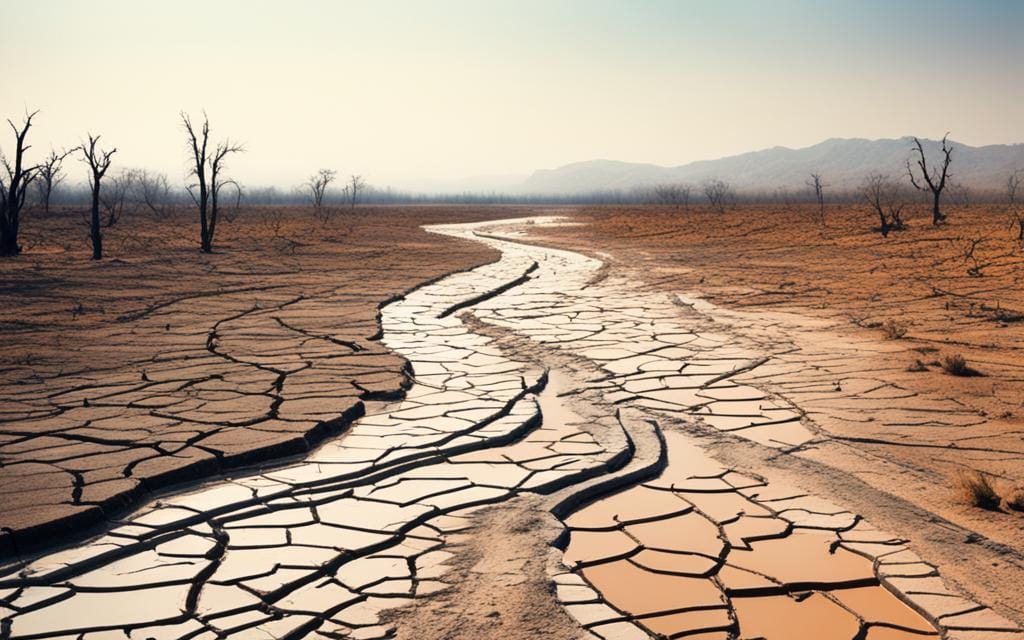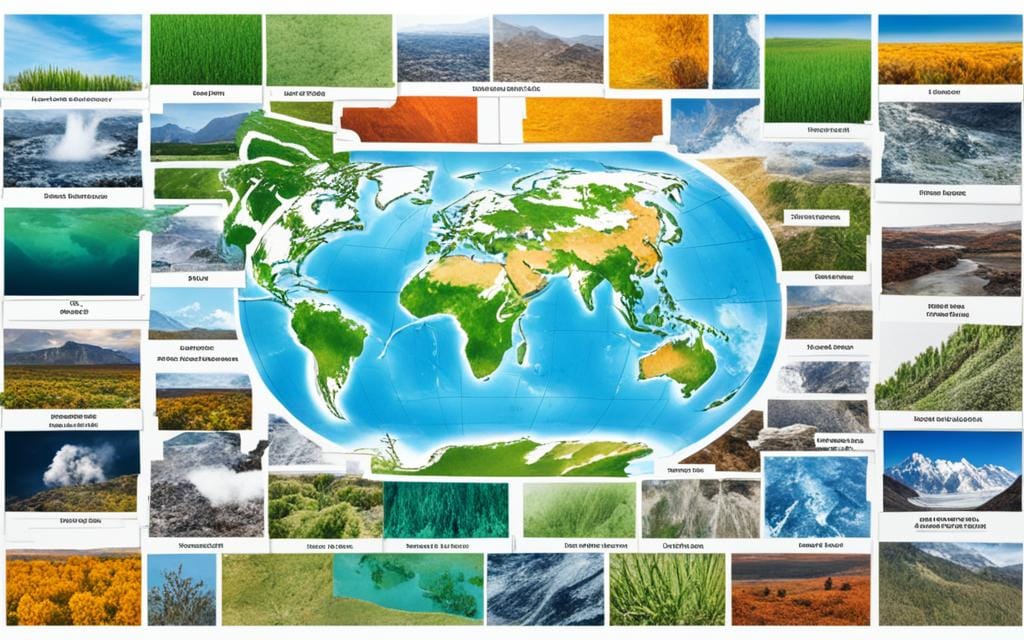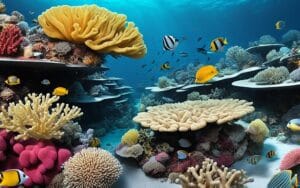How Is Climate Change Affecting the World? Climate change is changing our planet in big ways. Since 1901, global temperatures have gone up by about 1.98°F (1.1°C)1.
This has caused many problems like rising sea levels, unpredictable weather patterns, and damages to our food and water supplies. It also harms important infrastructure and endangers our health.
Dealing with these issues needs a worldwide plan to reduce harmful greenhouse gases and help vulnerable communities. This article looks into how climate change hits us and talks about ways to fix it.
Table of Contents
ToggleClimate Change: A Complex and Multifaceted Challenge
Climate change is a major global issue. It affects many areas of our lives. The impacts reach far beyond just rising temperatures2.
They include things like higher sea levels and changes in weather. These changes can harm ecosystems and much more. It’s important to see how everything is connected. This helps us come up with ways to fight climate change.
Understanding the Impacts of Climate Change
Since the Paris Agreement in 2015, we’ve made some progress. For example, we cut down how much greenhouse gas we might put out.
Yet, we still need to do more to lower these gases, aiming for a less than 2°C rise by 20302. We’ve already achieved a 1.1°C rise, making extreme weather worse2. This affects billions of people, especially those who are most vulnerable to climate change.
Interrelated Effects on Various Sectors
Climate change affects the world in different ways. Moving to a cleaner economy is tough. It requires money and changes in how we live and work3. We need to change both as individuals and as societies to lower emissions.
Investing in new green technologies is also key3. Poor and vulnerable communities feel the effects the most. Misinformation makes it harder to find solutions3. There are also ethical issues, such as fairness to future generations, and the fact that some damage could be permanent3.
Ninety-five percent of climate experts agree that human activities are causing global warming4. This consensus is based on research from around the world. Extreme weather events are more frequent and sea levels are rising4. These are just some of the ways climate change is affecting the planet. It’s clear we must take action together to address these challenges.
Rising Global Temperatures and Its Consequences
Greenhouse gases in our air are making the planet warmer. The past decade was the hottest we’ve seen. This caused more hot days and heat waves across the land5.
The Arctic is warming faster than anywhere else, melting glaciers and ice. This quick warming also leads to severe storms, droughts, and flooding in different places worldwide5.
Hotter Temperatures and Heat Waves
The Earth’s average temperature has gone up by about 2 degrees Fahrenheit. Since 1982, it’s warming three times faster, creating more heat waves.
2023 was the hottest year ever. The last 10 years have been the hottest on record5.
Melting Glaciers and Sea Ice
The poles are warming faster, causing ice to melt quickly. This speeds up sea level rise and harms Arctic animals. This affects the whole planet5.
Changing Weather Patterns
Not only is it getting hotter, but it’s also changing our weather. For every degree it warms, the air holds more water, causing heavier rains5.
It’s also making wildfires and hurricanes worse. Human societies and nature face big challenges, needing quick action6.
Extreme Weather Events: Storms, Droughts, and Wildfires
Climate change is making extreme weather more common and severe. This includes storms, hurricanes, and droughts7. Rising global temperatures evaporate more water into the air, making storms and floods worse7.
Warm ocean waters boost the power and number of tropical storms7. Moreover, droughts are getting more intense and lasting longer in some areas. This puts water supplies and food at risk7.
More Severe Storms and Hurricanes
In the United States, heatwaves, big downpours, and major hurricanes are on the rise8. The whole world is seeing more extreme weather events8. For every degree of temperature increase, the air can hold 7% more water7.
This leads to heavier rains that have gotten both more common and intense because of people’s actions7. In fact, scientists say climate change made a heavy rain event in northern Libya in September 2023 50 times more likely7.
Increased Drought and Water Scarcity
Climate change is also making droughts longer and harder in some places7. Five rainy seasons failed in East Africa between 2020 to 2022, forcing 1.2 million to leave their homes7. It also made severe droughts in East Africa and the Amazon 100 times more likely7. In Mali, a heatwave saw temperatures reach 48.5C, causing more people to get sick and die7.
In the western US, temperatures could jump by 5.5-11C (10-20F) higher than usual. This would risk more wildfires7. Canada had its worst wildfire season in 2023 due to these hotter, drier conditions linked to climate change7. Experts warn that major wildfires will happen more often and be more intense worldwide. They predict up to 50% more of these extreme fires by 21007.
| Extreme Weather Event | Impact |
|---|---|
| Hurricanes | Hurricane Katrina, Hurricane Harvey, and Hurricane Maria have each caused billions of dollars in damage, with costs ranging from $2.4 billion to $193.8 billion (2021 USD)8. |
| Droughts | Drought events in the US have incurred costs ranging from $2.4 billion to $40.5 billion (2021 USD), leading to significant agricultural losses, direct and indirect fatalities due to heat stress, and widespread impacts on water supplies and crop/livestock production8. |
| Wildfires | Extreme wildfires are projected to become more frequent and intense globally, with up to a 50% increase in the number of extreme fires by 2100 according to the UNEP7. |
These extreme weather events are damaging and disrupt communities. With our climate changing, we’re likely to see more extreme storms, droughts, and wildfires. This highlights the urgent need to act with solid plans to handle and fight these issues8.
Oceans in Peril: Warming, Rising, and Acidification
Our planet’s oceans face serious threats from climate change. They include ocean warming, sea level rise, and acidification. These problems are a huge danger to sea life, people living near coasts, and the ocean itself.
Seventy percent of our Earth is covered by the ocean9. It absorbs most of the warming happening worldwide9. The ocean’s top layer holds a lot of heat, impacting our climate. But, this warmth causes the ocean to heat up fast. This makes the sea levels climb.
The ocean is also getting more acidic from extra CO2 in the air9. This acidification is happening quicker than in millions of years10. A more acidic ocean makes life hard for sea creatures. They find it tough to make their shells and structures10.
We can already see negative effects from ocean acidification. U.S. shellfish supplies are expected to drop a lot by 210011. This includes a 35% decrease in clams and a 50% drop in oysters11. The impact could mean a loss of $230 million for the industry11. Also, the U.S. coral reef tour industry might lose over 90% of its value. This is due to the combined effects of acidification and warming11.
To tackle these problems, quick and clear steps must be taken. We need to cut down on fossil fuels and CO2 pollution right away11. Without this action, the future of our oceans is in great danger. The lives that rely on them are at risk91110.
Loss of Biodiversity and Ecosystem Disruption
Climate change is a major threat to our planet’s plants and animals. With temperatures rising and weather acting up, many species can’t keep up. This leads to a big loss in the variety of life forms on Earth. Currently, we’re seeing species disappear at a rate that’s a thousand times faster than usual12.
The impact of climate change on nature is huge. It affects the balance of life on land and in the sea. Due to these changes, about a million species are in danger of going extinct soon12. Insects and diseases that harm nature are doing well because of these changes. They’re making it hard for local plants and animals to survive13.
Biodiversity loss affects everyone. More than half of the wealth in the world comes from nature. Also, over a billion people depend on forests for their jobs12. When we mess with ecosystems, we open the door to sicknesses that jump from animals to people13.
| Ecosystem Impact | Statistic |
|---|---|
| Wetlands loss | 85% of wetlands have disappeared, such as salt marshes and mangrove swamps12. |
| Coral reef decline | Live coral reefs have nearly halved in the past 150 years12. |
| Deforestation rate | Deforestation destroys an area equivalent to 27 football pitches every minute13. |
| Threatened species | If current trends continue, one million animal and plant species are threatened with extinction13. |
We need to act fast to address this situation. We must work on climate change, protect natural homes, and use resources wisely. This way, we can save our rich variety of life and keep the world running well for us1213.
how is climate change affecting the world
Food Security and Agricultural Impacts
Climate change is deeply impacting food safety and agricultural output globally. It’s causing more heat, changing where it rains, and bringing more crazy weather events. These changes are harming crop growth and the amount of food we can get from animals around the globe14. This problem isn’t just about food. It affects people’s health, their jobs, and how they make money.
The effects on farming are huge. Things like droughts, floods, and too much heat are hurting the crops. And the oceans, which provide a lot of food, are becoming less healthy. This makes life very hard for people in poor countries and small islands. They’re already dealing with the worst health effects of climate change14.
Water Resources and Availability
Climate change is changing how much water we have and where we can find it. Glaciers are melting, rains are falling in different places, and more water is evaporating. This means that many places are running out of water quicker and more often14. It’s getting harder to grow food and feed animals, making the food supply even tighter.
Many people are already without clean water, over 2 billion to be exact14. If we don’t act, more people might get sick or even die from water or food diseases. Solving these water issues is key to lessening climate change’s hit on health, jobs, and how we make money.

Dealing with climate change’s many issues is tough. But, making sure we have enough to eat and drink is really important. Tackling these challenges needs everyone to work together. We must lower greenhouse gases, change the way we farm and use water, and help those who are most at risk1516.
Human Health Risks and Challenges
Climate change is a huge threat to our health, causing serious problems we can’t ignore17. As temperatures rise, more people get sick from the heat and some even die. By the end of the century, thousands to tens of thousands more could die each year in the U.S. from the heat during summers17.
In contrast, warm winters might lower cold-related deaths. But, it’s not enough to offset the higher numbers of heat-related deaths17.
Climate change also makes the air we breathe worse, affecting 57 million Americans17. It’s expected that warmer temperatures will cause more days with bad air quality. This increase could mean more people dying or getting sick from breathing problems due to ozone17.
Heat-Related Illnesses and Mortality
Heat isn’t the only danger from climate change. It’s also expected to make wildfires more common and severe. Smoke from these fires can worsen breathing issues, especially for older adults. They face a higher risk of getting seriously sick or dying from the smoke17.
Spread of Infectious Diseases
Climate change can alter where disease-carrying creatures like mosquitoes and ticks live. This could spread certain illnesses to new areas. Plus, more rain, storm surges, and warmer oceans can also boost illnesses spread through water18.
Climate change affects many health areas, from breathing and heart problems to our minds and certain groups’ risks18. Solving these issues needs a big public health effort. We have to think about how all these effects are connected and how to protect everyone18.
Experts think climate change could lead to 250,000 more deaths each year for the next few decades. That’s serious, and it shows how urgent it is to act19. Yet, not much money aimed at solving these health issues comes from global climate funds. We need to put more resources into making health systems climate-ready19.
Groups like the WHO and PAHO are working on projects to gather country-specific information and support smart health policies. This includes better ways to watch for health threats and making our health systems more able to face climate change. Together, we can lower the health risks of climate change and create a healthier future for everyone19.
Climate-Induced Migration and Displacement
The impacts of climate change are causing more people to leave their homes than ever before. From 2010 to 2019, about 23.1 million people each year were forced away by weather events20. They leave their homes to find safety, often coming from the most vulnerable areas. This situation leads to even more poverty and difficulties for them.
The numbers are overwhelming. The World Bank says climate change will lead to up to 86 million more migrants in sub-Saharan Africa by 205021. It also predicts 40 million in South Asia and 17 million in Latin America will move because of climate change. By 2050, about 3.4 billion people will live in places where the environment is under serious threat21. Helping these people and areas means the world must work together.
Many factors play a role in the migration crisis, such as extreme weather, rising seas, and not enough water or food. For instance, in Syria, over 10.5 million people left rural areas because of drought and failed crops between 2007-201020. In Central America, more than five million farmers had to leave because of climate issues21.
This movement affects everyone. In South Sudan, more than a third of the population is displaced. Somalia and the Central African Republic are also seeing big changes because of people needing to move21. We must focus on helping those who have to leave and the places they go to.
In 2020, over 40.5 million people had to move because of natural disasters. Floods and storms alone forced nearly 28 million people to leave their homes22. By 2050, it’s expected climate change will lead to about 143 million more people being displaced22. To deal with this, the world needs to come together and help those in need while making vulnerable places stronger.
| Region | Projected Climate Migrants by 2050 |
|---|---|
| Sub-Saharan Africa | 86 million |
| South Asia | 40 million |
| Latin America | 17 million |
The challenge of climate migration and displacement is getting more serious every day. We need a global effort to take care of those at risk and make the future better for everyone. Working together, we can mitigate these effects and support a sustainable planet202122.
Infrastructure Vulnerability and Adaptation Needs
Climate change is making our infrastructure more vulnerable to damage23. Over the next 15 years, the U.S. transportation system will face hotter average temperatures, heat waves, and more extreme weather events23.
This includes heavy rainfall, which can harm tunnels, culverts, roads, and transit stations23. Coastal areas are at high risk, with sea level rise and storm surges posing threats to bridges, ports, and power grids24. Should a major flood occur, Paris could see 30% to 55% of its overall flood damage hit its infrastructure sector24.
Coastal Infrastructure and Sea Level Rise
Our coastal structures are the first to feel the climate crisis23. With sea levels rising and extreme weather increasing, these assets face more risk of flooding, erosion, and harm23.
The U.S. DOT Volpe Center is looking into the economic effects of flooding on transportation in Hampton Roads, Virginia23. It’s crucial to adjust this infrastructure to face climate issues. This is key for the resilience of our coastal areas.
Resilience and Climate-Proofing Infrastructure
It’s vital to make our infrastructure resilient to protect communities from climate change impacts23. The FHWA’s Framework helps agencies check how vulnerable their infrastructure is to severe weather changes2324.
It also helps them add adaptation measures to their plans. The FHWA report suggests that making cities safe from floods is a smart investment24. Using nature-based or innovative methods in building climate-resilient infrastructure may be cheaper than the usual ways24.
Programs like the PROTECT Grant and RDR Tool Suite are aiding the U.S. to make its transport and other infrastructure more resilient23. This involves including climate adaptation strategies in infrastructure planning and design23. Doing so will help safeguard our communities from the more severe climate threats.
Addressing infrastructure vulnerabilities due to climate change is key for community safety and success25. The IPCC has detailed the world’s readiness and need for climate change adaptations in its Sixth Assessment Report25.
Disproportionate Impacts on Vulnerable Communities
Climate change affects the world, but not everyone feels it the same way. Some groups face more impact, like those with less support and protection. For example26, Black and African American people experience worse effects from climate change. They are more affected by certain issues, like childhood asthma increasing because of the heat. This effect gets even more serious if the planet gets hotter26. Plus, they’re also more likely to face extreme heat deaths26.
Hispanic and Latino communities also feel climate change strongly. This is because many work in jobs like building or farming that are hit hard by temperature changes26. With the world getting warmer, these individuals are more at risk of losing work hours because of extreme heat. They also have more trouble with things like traffic delays due to flooding26.
Things like not having much money, not enough healthcare, and poor housing make these impacts worse27. This includes kids, older adults, and those with health issues27. Poverty and discrimination make it even harder for these groups to cope with climate changes. We can help by making special plans that meet their needs and keep them healthier.
It’s vital to help the most affected by climate change and make the move to a fairer, more green world27. When we look at who’s most at risk, we can better help them. This means working closely with these communities to make sure the help we offer is what they truly need27. Figuring out what ways to help work best is also key in making these communities stronger against climate change.
Climate change doesn’t impact everyone equally, and this is a worldwide problem28. For example, in Hong Kong, many homes get too hot, causing harm. The heat is especially dangerous for older people. In the US, people of color breathe in a lot more pollution than others. On the other hand, Caucasians face much less pollution.
These different levels of pollution show how unfair climate effects can be28. Regions like Africa suffer a lot from climate change, even though they contribute less to the problem. The story is similar for the Philippines, which is hit hard by typhoons and such, yet it adds very little to the global pollution. These examples show why it’s crucial to tackle climate impact issues affecting the most vulnerable28.
Reducing Emissions and Mitigating Climate Change
The battle against climate change can still be won. We have the power to steer clear of major risks by slowing down global warming29. One important step is to move towards using renewable energy sources like solar and wind power. This will lower harmful emissions from producing electricity29. Also, small changes in our daily lives, like using less energy at home and reducing what we buy, can add up to big benefits for the planet30.
Transition to Renewable Energy
Gearing up with renewable energy is key in reducing harmful emissions. The European Union is way ahead, having cut emissions by over 31% by 2022, versus 199029. They’ve put in place around 3,000 ways to fight climate change. With existing efforts, they aim to slash emissions even further to 43% by 203029. In 2022, over a fifth of the EU’s energy came from renewable sources, surpassing their goal29. To top it off, keeping up the work and introducing new green technologies is crucial to push this transition forward on a global scale.
Sustainable Practices and Lifestyle Changes
Moving to renewable energy is crucial, but changing how we live also makes a big difference in the fight against climate change. Better efficiency in our houses, factories, and how we move around can cut emissions in many areas30.
Farming and managing forests in smarter ways can lock away carbon and lower emissions from the land sector30. Taking care of key ecosystems such as wetlands and forests boosts our fight against climate change and protects wildlife30. By each doing our part, everybody can help minimize climate change’s effects.
Thanks to ongoing studies and new ideas in renewable energy and sustainable living, there’s light at the end of the tunnel. But turning these ideas into action needs a full-on, worldwide push293031. Together, we can shape a world that’s ready to face the challenges ahead while keeping our planet safe.
Conclusion
Climate change is a big problem impacting our world32. It’s mainly caused by human actions, such as our emissions. These emissions have warmed the Earth significantly since 195032.
Greenhouse gases alone have warmed Earth more than a third since 1850. But, humans also create cooling aerosols. These aerosols will drop by 2100, making warming mainly from greenhouse gases2. By 2030, greenhouse gas emissions need to drop by 28% for the 2°C goal and by 42% for the 1.5°C goal2.
Climate change leads to higher temperatures and sea levels. It causes more extreme weather and harms food and water supplies16. This crisis impacts everyone from increasing temperatures to more severe weather events16. It makes heatwaves, wildfires, and droughts worse, affecting billions of people16.
Dealing with this issue demands a worldwide effort. We need to lower emissions and help vulnerable groups. To limit warming to 1.5°C, we must cut emissions by 45% by 2030 and achieve ‘net zero’ by 20502. This means using more renewable energy and changing our ways. If we act now, we can make the future better for everyone.
Source Links
- https://www.noaa.gov/education/resource-collections/climate/climate-change-impacts
- https://www.un.org/en/global-issues/climate-change
- https://www.linkedin.com/pulse/what-major-challenges-climate-change-kai-schiller
- https://medium.com/@chrisjriedy/climate-change-the-multi-faceted-phenomenon-b8e15a4a2c46
- https://www.nationalgeographic.com/environment/article/global-warming-effects
- http://www.climate.gov/news-features/understanding-climate/climate-change-global-temperature
- https://www.bbc.com/news/science-environment-58073295
- https://www.c2es.org/content/extreme-weather-and-climate-change/
- https://climatekids.nasa.gov/ocean/
- https://coastadapt.com.au/ocean-acidification-and-its-effects
- https://www.ucsusa.org/resources/co2-and-ocean-acidification
- https://www.un.org/en/climatechange/science/climate-issues/biodiversity
- https://www.nhm.ac.uk/discover/how-are-climate-change-and-biodiversity-loss-linked.html
- https://www.who.int/news-room/fact-sheets/detail/climate-change-and-health
- https://www.wwf.org.uk/learn/effects-of/climate-change
- https://www.nature.org/en-us/what-we-do/our-priorities/tackle-climate-change/climate-change-stories/climate-change-frequently-asked-questions/
- https://climatechange.chicago.gov/climate-impacts/climate-impacts-human-health
- https://www.niehs.nih.gov/research/programs/climatechange/health_impacts
- https://www.paho.org/en/topics/climate-change-and-health
- https://unfccc.int/files/adaptation/groups_committees/loss_and_damage_executive_committee/application/pdf/briefing_paper_climate_induced_displacement_and_migration.pdf
- https://www.visionofhumanity.org/climate-change-induced-migration-conflict/
- https://www.nature.com/articles/s44168-024-00133-1
- https://www.volpe.dot.gov/our-work/assessing-infrastructure-climate-change-vulnerability-and-impacts-and-promoting-resilience
- https://www.oecd.org/environment/cc/policy-perspectives-climate-resilient-infrastructure.pdf
- https://www.ipcc.ch/report/ar6/wg2/
- https://www.epa.gov/newsreleases/epa-report-shows-disproportionate-impacts-climate-change-socially-vulnerable
- https://www.niehs.nih.gov/research/programs/climatechange/health_impacts/vulnerable_people
- https://earth.org/marginalised-groups-are-disproportionately-affected-by-climate-change/
- https://www.eea.europa.eu/en/topics/in-depth/climate-change-mitigation-reducing-emissions
- https://climatepromise.undp.org/news-and-stories/what-climate-change-mitigation-and-why-it-urgent
- https://www.ccacoalition.org/content/why-we-need-act-now
- https://www.carbonbrief.org/analysis-why-scientists-think-100-of-global-warming-is-due-to-humans/









